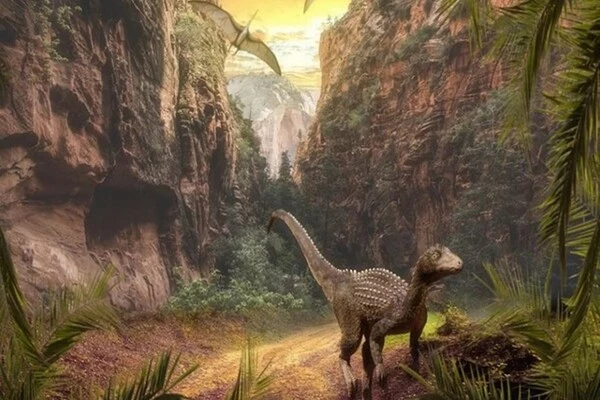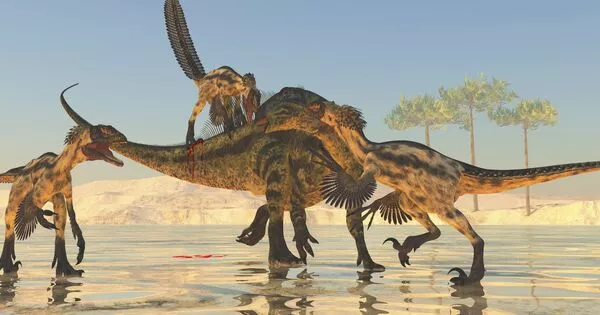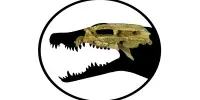Dinosaur teeth can reveal a lot about the diet of a particular species. For example, the presence of serrations or ridges on the teeth can indicate that the dinosaur was a predator, while the absence of these features may suggest that the dinosaur was a herbivore. Additionally, the shape and size of the teeth can also provide clues about the types of food that a dinosaur may have consumed. For example, a dinosaur with large, flat teeth may have been well-suited for crushing plants, while a dinosaur with sharp, pointed teeth may have been a hunter. In addition to this, Fossilized feces, tooth wear patterns and isotopic analysis also can provide information about the diet of a dinosaur.
Scratches on dinosaur teeth may reveal what they consumed. Dental microwear texture analysis (DMTA) has been used for the first time to infer the feeding habits of large theropods such as Allosaurus and T. rex. Researchers could deduce which dinosaurs crunched on hard bone and which ate softer foods and prey by taking 3D images of individual teeth and analyzing the pattern of marks scratched into them. This technique opens up a new field of study for paleontologists, allowing us to better understand not only dinosaurs but also the environments and communities in which they lived.
From Fantasia to Jurassic Park, the T. rex is seen as a terrifying apex predator that would chase down its prey and crunch on it whole. But how much did this iconic dinosaur actually chow down on bones? And what about other predatory dinosaurs that existed long before it?
We wanted to see if we could use DMTA to find evidence of different feeding behaviors in tyrannosaurids (from the Cretaceous period, 145 million to 66 million years ago) compared to the older Allosaurus (from the Jurassic period, 201 million to 145 million years ago).
Daniela Winkler
Researchers from the University of Tokyo, in collaboration with teams from the University of Mainz and the University of Hamburg in Germany, have used dental microwear texture analysis (DMTA), a scanning technique to examine topographical dental wear and tear in microscopic detail, on individual dinosaur teeth from more than 100 million years ago to better understand what they may have eaten.
“We wanted to see if we could use DMTA to find evidence of different feeding behaviors in tyrannosaurids (from the Cretaceous period, 145 million to 66 million years ago) compared to the older Allosaurus (from the Jurassic period, 201 million to 145 million years ago),” postdoctoral fellow Daniela Winkler of the Graduate School of Frontier Sciences explained. “We already knew from previous research that tyrannosaurids could crack and feed on bones (from studies of their feces and bite marks on bone). Allosaurs, on the other hand, are much older and have less information.”
DMTA has mainly been used to study mammal teeth, so this is the first time it was used to study theropods. The same research team from the University of Tokyo also recently pioneered a study on DMTA in Japanese sauropod dinosaurs, famous for their long necks and tails. A high-resolution 3D image was taken of the tooth surface at a very small scale of 100 micrometers (one-tenth of a millimeter) by 100 micrometers in size. Up to 50 sets of surface texture parameters were then used to analyze the image, for example, the roughness, depth and complexity of wear marks.
If the complexity was high, i.e., there were different-sized marks that overlaid each other, this was associated with hard object feeding, such as on bone. However, if the complexity was low, i.e., the marks were more arranged, of a similar size, and not overlapping, this was associated with soft object feeding, like meat.

In total, the team studied 48 teeth, 34 from theropod dinosaurs and 14 from crocodilians (modern crocodiles and alligators), which were used as a comparison. The team was able to study original fossilized teeth and take high-resolution silicon molds, thanks to loans provided by natural history museums in Canada, the U.S., Argentina and Europe. “We actually started dental microwear research of dinosaurs in 2010,” said Lecturer Mugino Kubo from the Graduate School of Frontier Sciences.
“My husband, Dr. Tai Kubo, and I had started collecting dental molds of dinosaurs and their contemporaries in North and South Americas, Europe, and of course Asia. Since Daniela joined my lab, we utilized these molds to make a broader comparison among carnivorous dinosaurs.”
“It was especially challenging to carry out this research during the pandemic,” said Winkler “as we rely on being able to gather samples from international institutions. The sample size might not be so large this time, but it is a starting point.”
What surprised Winkler was that they didn’t find much evidence of bone crushing behavior in either Allosaurus or tyrannosaurids, despite the fact that tyrannosaurids ate bone. This unexpected result could be due to a number of factors. It’s possible that, while Tyrannosaurus could eat bone, it was less common than previously thought. Furthermore, because the team had to use well-preserved teeth, it is possible that the extremely damaged teeth that were excluded from this study were in such a state because the animals fed more on bone.
The team did discover a distinct difference between juveniles and adults in both dinosaurs and crocodilians. “When we studied two juvenile dinosaur specimens (one Allosaurus and one tyrannosaurid), we discovered that they had very different feeding niches and behaviors than adults. We discovered that juvenile teeth were more worn, which could indicate that they had to feed on carcasses more frequently because they were eating leftovers “Winkler clarified. “We were also able to detect different feeding behavior in juvenile crocodilians, but it was the opposite this time. Adult crocodilians had more dental wear from eating harder foods, such as larger vertebrates, while juveniles had less dental wear from eating softer foods, such as insects.”
According to Winkler, the next step in dinosaur research will most likely be a closer look at the long-necked sauropods, which the team has also been studying. For the time being, however, she is experimenting with something much, much smaller: crickets. Although the insects’ mouths are tiny and lack teeth, the researchers want to see if they can still detect evidence of mouth wear using the same technique.
“Using DMTA, we may be able to reconstruct extinct animals’ diets and draw conclusions about extinct ecosystems, paleoecology, and paleoclimate, and how they differ from today,” Winkler said. “But this research is also about curiosity. We want to form a clearer image of what dinosaurs were really like and how they lived all those millions of years ago.”
















